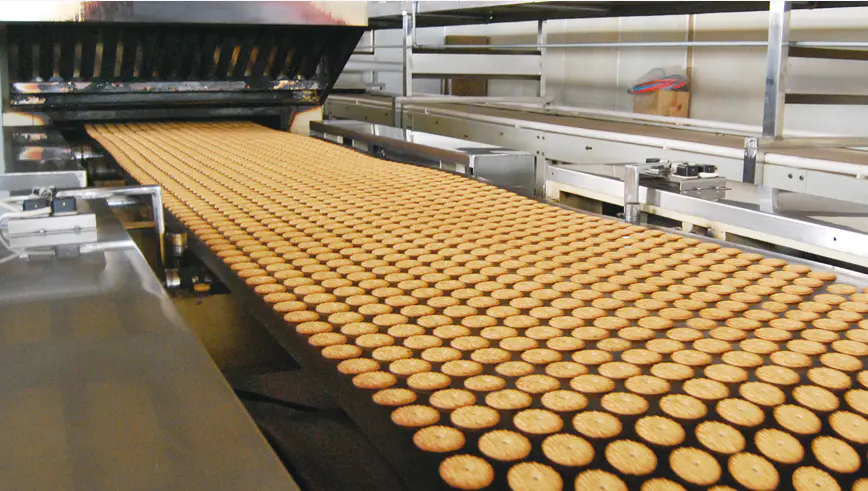1. Dough Preparation System
This is the foundational step in biscuit manufacturing, where raw ingredients are mixed and prepared into dough.
Ingredient Mixing
Key ingredients—wheat flour, sugar, fat (butter or oil), water, leavening agents (such as baking soda), and flavorings—are precisely measured and added to large industrial mixers. The goal is to form a homogenous mixture with the desired texture and consistency.
Dough Kneading
Once ingredients are mixed, the dough is kneaded to develop gluten and ensure an even distribution of all components. The kneading duration and intensity depend on the biscuit type—short doughs require minimal gluten development, while harder biscuits may need longer kneading.
Resting (Optional)
For some biscuit types, especially laminated or flaky ones, the dough is rested (usually 15–30 minutes). Resting allows the gluten to relax, improving the dough’s handling characteristics and ensuring uniformity during forming.
2. Dough Feeding and Sheeting
This stage prepares the dough into a continuous sheet for further shaping.
Dough Feeding
The kneaded dough is transferred from the mixing section to the sheeting equipment using mechanical conveyors, extruders, or manually in small-scale setups.
Sheeting Process
The dough passes through a series of rollers that gradually flatten it into a thin sheet with uniform thickness. For certain products, laminating systems are used to create multiple layers, which gives a flaky texture—ideal for crackers and puff-type biscuits.
3. Biscuit Forming / Shaping
This step determines the final shape, pattern, and thickness of the biscuits.
Rotary Moulding
Used for soft dough biscuits like butter or shortbread cookies. The dough is pressed into engraved rollers which form the biscuit shape and design before being released onto the conveyor.
Rotary Cutting
Ideal for harder doughs. A rotary cutter with sharp edges cuts the dough sheet into various shapes (e.g., round, square, animal shapes). Often, a rotary moulder is used in tandem for intricate designs.
Wire Cutting
For sticky or chunky doughs (e.g., chocolate chip cookies), the dough is extruded through nozzles and cut by a moving wire into uniform pieces.
Embossing or Stamping
Brand logos or decorative patterns can be stamped onto the surface of each biscuit using embossed rollers or stamping dies.
4. Baking
The formed dough pieces are then baked to develop texture, flavor, and color.
Tunnel Oven
The biscuits move through a continuous tunnel oven, typically 20–50 meters long, divided into heating zones (preheating, baking, coloring, and cooling zones).
Temperature & Time
Baking is done at 180°C to 250°C for around 5 to 12 minutes, depending on biscuit type, thickness, and moisture content. The baking removes water, expands the dough, and browns the surface through the Maillard reaction.
Oven Types
Gas-fired ovens: Common in large-scale operations due to efficiency.
Electric ovens: Suitable for controlled environments.
Convection ovens: Use hot air circulation to ensure even baking.
5. Cooling
After baking, biscuits are hot and fragile. Cooling is essential to stabilize their structure and prevent moisture buildup in packaging.
Cooling Conveyor
Biscuits are transported on long mesh conveyors (10–20 meters) to cool naturally with ambient air. The duration depends on product type and ambient conditions.
Controlled Cooling
For high-speed lines or climate-sensitive areas, forced-air cooling or chilled air systems are used to speed up the cooling process without affecting product quality.
Proper cooling enhances crispness and prepares the biscuits for packaging without risk of condensation.
6. Packaging System
This stage involves the alignment, counting, wrapping, and boxing of biscuits.
Stacking & Feeding
Biscuits are aligned either in stacks or rows. Automated feeders count and group them based on packaging requirements.
Primary Packaging
Flow wrap machines: Pack biscuits individually or in rows using plastic film.
Tray packs: Place biscuits in trays for protection and visual appeal.
Roll wraps: Used for cylindrical biscuits like sandwich or cream-filled cookies.
Secondary Packaging
Primary packs are then placed into cartons or boxes for shipping. Cartoners, case packers, and palletizers automate this step. Additional systems like metal detectors, weigh checkers, and barcode scanners ensure quality and traceability.
7. Optional Automation and Quality Control
Modern biscuit lines integrate intelligent control systems to enhance efficiency and consistency.
Vision Inspection Systems
Cameras and sensors check biscuits for color, size, cracks, or deformation. Defective products are automatically rejected.
Metal Detectors & X-ray Systems
Ensure no metallic or foreign objects are present in finished products, complying with food safety regulations.
PLC & SCADA Control
Programmable Logic Controllers (PLC) and Supervisory Control and Data Acquisition (SCADA) systems monitor the entire production process, allowing real-time adjustments, energy tracking, and process optimization.
Advantages of a Modern Biscuit Production Line
High Efficiency: Capable of producing thousands of biscuits per hour.
Consistency: Every piece is uniform in shape, weight, and taste.
Flexibility: Can switch between different recipes and formats.
Labor Savings: High automation reduces manual intervention.
Hygiene Control: Closed systems minimize contamination risks.































